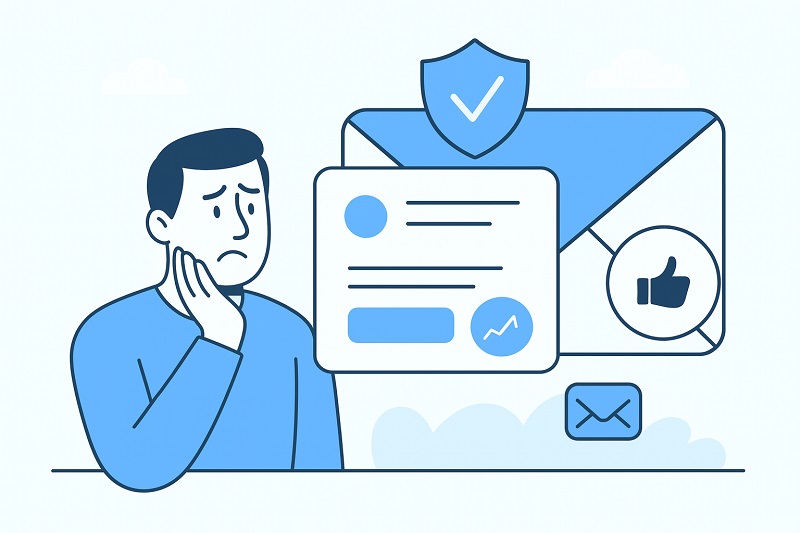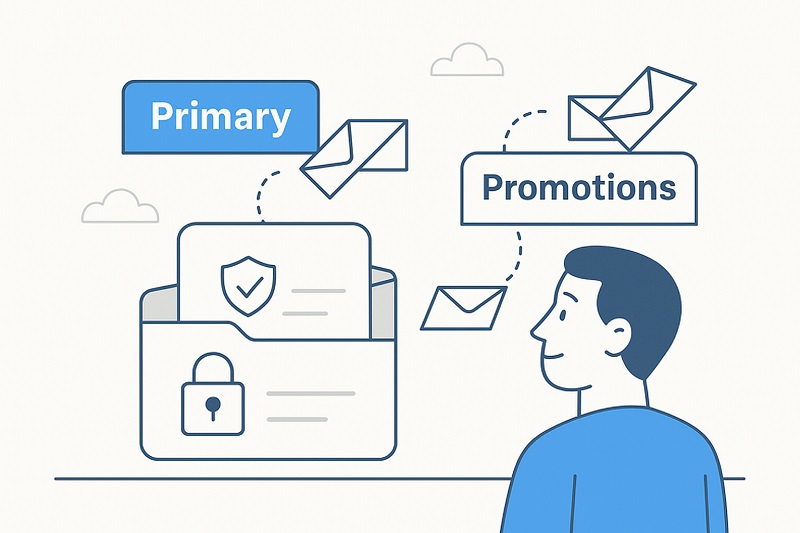As we look toward 2026, one thing is clear: the landscape of email deliverability is changing at a rapid pace. Filters are evolving, engagement thresholds are tighter, and inbox providers are using smarter technology to decide what deserves a place in the inbox.
If your open rates have slipped lately or your campaigns are ending up in promotions instead of primary, you’re not alone. The same tactics that worked a year ago just don’t pass the test anymore.
In this article, we’ll unpack the biggest shifts happening right now, what to expect in the months ahead, and the best ways to stay ahead of Gmail, Yahoo, and Outlook’s new rules.
Key takeaways
- AI-powered inbox filters will increasingly rely on behavior and engagement, rather than just content.
- Google and Yahoo are tightening enforcement of authentication and domain reputation rules.
- Deliverability will depend increasingly on list quality, real-time monitoring, and user trust.
1. The Rise of AI-Driven Filtering
The biggest change going into 2026 is how inbox filters use artificial intelligence.
Gmail and Yahoo have moved far beyond simple spam rules. Mailbox algorithms now look at how people interact with your emails over time: How often they open, click, delete, or mark them as spam.
If your audience reads, clicks, and saves your emails, that sends a clear signal: “This sender is trusted.”
If they delete, ignore, or report them, the algorithm starts downgrading your entire domain reputation. And that happens fast, sometimes within a few days.
What to expect in 2026
- Mailbox AI will weigh micro-engagement signals like how quickly people open your email or whether they move it from spam to inbox.
- Filters will rely less on volume history and more on behavioral patterns.
- Engagement recovery will take longer once reputation drops, so consistency is key.
What you can do
Segment by engagement. Send less often to quiet subscribers. Keep your subject lines short, your message clear, and your templates lightweight.
And if you need help restoring your reputation after a dip, tools like InboxAlly can help by creating authentic engagement signals that rebuild trust naturally.
Simple, clean designs often perform better than elaborate layouts.
At InboxAlly, we’ve observed the impact of even minor engagement drops; changes in inbox placement can happen within just days!
2. Authentication Is Now Mandatory
![]()
By early 2025, Gmail and Yahoo officially required SPF, DKIM, and DMARC for all bulk senders. In 2026, enforcement will tighten even more. Expect stricter alignment checks, additional validation layers, and possibly new sender reputation thresholds.
What’s new this year
- Gmail has started flagging messages with incomplete alignment between “From” and “DKIM” domains.
- Yahoo is expected to expand its policy enforcement to smaller-volume senders.
- Some ESPs will begin automatically blocking unverified domains to protect deliverability.
What you can do right now
- Double-check that SPF, DKIM, and DMARC are not only present but also properly aligned.
- Monitor your DMARC reports monthly.
- If you send from multiple subdomains or IPs, make sure they’re authenticated too.
- Review your DNS records quarterly to catch any expired keys or updates.
Inbox providers are making it clear: if your identity isn’t verified, your messages won’t make it past the gate. Proper authentication also helps you maintain a reputable sender profile and reduce spam complaints before they damage your reputation.
3. Engagement Takes Center Stage
In 2026, “set and forget” no longer works. Reputation can change in days, not months, especially when engagement drops or bounce rates increase. Keeping your audience consistently engaged is now one of the strongest ways for email marketers to protect deliverability and overall email campaign performance.
What’s changing
- Expect faster reputation recalculations – daily or even hourly for high-volume senders.
- A few bad sends can trigger a deliverability downgrade almost immediately.
- Manual audits won’t cut it; real-time monitoring will be essential.
How to adapt
Use Google Postmaster Tools or InboxAlly to track inbox placement and spam rates weekly.If something drops, look for the cause right away: a new list segment, template change, or low-performing campaign. Acting within a day or two can prevent long-term damage.
4. Smaller Lists, Higher Quality
The “send to everyone” strategy is officially over.
Mailbox providers are now prioritizing engagement ratio over total send volume. In other words, 1,000 engaged subscribers beat 10,000 passive ones every time.
New in 2026
- Providers may automatically deprioritize inactive segments within your list.
- Some ESPs are rolling out automated list-cleaning recommendations based on engagement data.
- Low-quality lists can now trigger rate limits or slow delivery.
How to stay ahead
Audit your list regularly. Remove or re-engage anyone who hasn’t interacted in 6–9 months.And keep bounce rates under 2% and spam complaints below 0.1%.
When possible, collect new subscribers with double opt-in; it’s becoming the gold standard for compliance and reputation.
5. Privacy and Compliance Become Deliverability Factors
Privacy rules aren’t just legal guidelines anymore; they’re being baked into deliverability scoring. Mailbox providers are measuring whether senders follow permission-based practices, provide easy opt-outs, and honor unsubscribe requests quickly.
What’s coming in 2026
- Expect mailbox filters to include “user trust” signals such as unsubscribe speed, consent verification, and complaint handling.
- Regional privacy laws (like Canada’s CPPA and new EU updates) will influence global sender standards.
Action steps
Take a moment to check your consent logs and privacy notices.
Every email should include a one-click unsubscribe option, and your signup forms should clearly record explicit consent, as mailbox providers like Gmail and Yahoo will factor complaint rates into their trust in a sender.
6. AI Tools Replace Manual Deliverability Audits
AI isn’t just changing how inboxes filter email; it’s also changing how marketers manage deliverability. Manual checks and monthly audits are being replaced by tools that identify issues in real time, flag risky content, and even predict spam placement.
How this plays out in 2026
- AI-powered deliverability platforms like InboxAlly now track engagement, sender reputation, and inbox placement continuously.
- Predictive models can warn you before campaigns underperform.
- You can test subject lines and message structure before sending to avoid spam-trigger patterns.
It’s no longer about reacting when deliverability drops. The smartest teams are using automation to prevent problems entirely.
7. Engagement Becomes the Ultimate Score
By the end of 2026, engagement will be the single most powerful factor in inbox placement.Mailbox algorithms are evolving to evaluate not just if people open your emails, but how they interact afterward. Do they click, forward, or reply?
The new rules of engagement
- Engagement from new subscribers counts more heavily than from long-term ones.
- Repeatedly sending to unresponsive contacts will drag down your domain reputation.
- Personalization, relevance, and timing all carry more weight than ever before.
How to win
- Try running a few A/B tests to see when your audience actually opens your emails.
- Send content that’s useful right away, not just nice to read.
- Stick to one main point per email so your message is easy to follow.
- Every time someone clicks or replies, it tells the algorithm your emails deserve a place in the inbox. That’s what builds trust in 2026.
8. Inbox Placement vs. Promotions: The New Gray Area
As inbox filters evolve, getting out of the spam folder is no longer the only challenge. In 2026, the real battleground is the promotions tab. Gmail’s machine learning systems now classify messages not just by technical setup or sender reputation but also by intent and engagement patterns.
Even well-authenticated senders with clean reputations are finding their campaigns consistently landing in promotions. This does not always mean your emails are failing; it simply means the algorithm believes they are primarily commercial or repetitive in nature.
What’s changing
- Gmail’s classifiers now factor in content structure, frequency, and offer-heavy wording when assigning placement.
- Repetitive campaign formats, identical templates, or overused CTAs can increase the likelihood of being filtered into promotions.
- Reply rates and conversation-style engagement are becoming stronger signals of primary placement.
Why it matters
Being stuck in promotions does not necessarily kill deliverability, but it can lower visibility and engagement. Many users ignore that tab entirely, which can indirectly affect your sender reputation over time. Consistent promotion placement also limits how your campaigns perform in Gmail’s predictive inbox algorithm.
How to adapt
- Mix up your campaign types and send educational, story-driven, or insight-based emails between sales offers.
- Encourage natural engagement by asking questions or requesting feedback from subscribers.
- Avoid using too many promotional phrases or heavy imagery; a conversational tone often performs better.
- Monitor your placement using tools like InboxAlly to understand where your messages land and adjust your content accordingly.
The promotions tab is not the end of the world, but in 2026, it is becoming a key differentiator between good and great deliverability. Balancing commercial intent with authentic, relationship-focused content is what will keep you visible in the primary inbox.
The Bottom Line
The real advantage in 2026 will belong to senders who stay proactive. That means tracking inbox placement in real time, learning from engagement data, and adapting before algorithms make the decision for you.
Solutions like InboxAlly are part of that shift, offering practical visibility and feedback that help marketers maintain consistent inbox performance as the rules continue to evolve.


